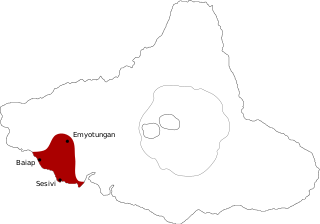
In grammar, the genitive case is the grammatical case that marks a word, usually a noun, as modifying another word, also usually a noun—thus indicating an attributive relationship of one noun to the other noun. A genitive can also serve purposes indicating other relationships. For example, some verbs may feature arguments in the genitive case; and the genitive case may also have adverbial uses.

Fijian is an Austronesian language of the Malayo-Polynesian family spoken by some 350,000–450,000 ethnic Fijians as a native language. The 2013 Constitution established Fijian as an official language of Fiji, along with English and Fiji Hindi and there is discussion about establishing it as the "national language". Fijian is a VOS language.
A possessive or ktetic form is a word or grammatical construction used to indicate a relationship of possession in a broad sense. This can include strict ownership, or a number of other types of relation to a greater or lesser degree analogous to it.
In linguistics, a possessive affix is an affix attached to a noun to indicate its possessor, much in the manner of possessive adjectives.
In linguistics, inalienable possession is a type of possession in which a noun is obligatorily possessed by its possessor. Nouns or nominal affixes in an inalienable possession relationship cannot exist independently or be "alienated" from their possessor. Inalienable nouns include body parts, kinship terms, and part-whole relations. Many languages reflect the distinction but vary in how they mark inalienable possession. Cross-linguistically, inalienability correlates with many morphological, syntactic, and semantic properties.
Rapa Nui or Rapanui, also known as Pascuan or Pascuense, is an Eastern Polynesian language of the Austronesian language family. It is spoken on Easter Island, also known as Rapa Nui.

East Ambae is an Oceanic language spoken on Ambae, Vanuatu. The data in this article will concern itself with the Lolovoli dialect of the North-East Ambae language.
Classical Kʼicheʼ was an ancestral form of today's Kʼicheʼ language, which was spoken in the highland regions of Guatemala around the time of the 16th-century Spanish conquest of Guatemala. Classical Kʼicheʼ has been preserved in a number of historical Mesoamerican documents, lineage histories, missionary texts, and dictionaries. Most famously, it is the language in which the renowned highland Maya mythological and historical narrative Popol Vuh is written. Another historical text of partly similar content is the Título de Totonicapán.
The Wuvulu-Aua language is a language spoken on the Wuvulu and Aua Islands, and by speakers across the Manus Province of Papua New Guinea. Although the Wuvulu-Aua language has a similar grammatical structure, word order, and tense to other Oceanic languages, it has an unusually complex morphology.
The Owa language is one of the languages of Solomon Islands. It is part of the same dialect continuum as Kahua, and shares the various alternate names of that dialect.
Bororo (Borôro), also known as Boe, is the sole surviving language of a small family believed to be part of the Macro-Gê languages. It is spoken by the Bororo, hunters and gatherers in the central Mato Grosso region of Brazil.
Lau, also known as Mala, is an Oceanic language spoken on northeast Malaita, in the Solomon Islands. In 1999, Lau had about 16,937 first-language speakers, with many second-language speakers through Malaitan communities in the Solomon Islands, especially in Honiara.
Paamese, or Paama, is the language of the island of Paama in Northern Vanuatu. There is no indigenous term for the language; however linguists have adopted the term Paamese to refer to it. Both a grammar and a dictionary of Paamese have been produced by Terry Crowley.
Tiri, or Mea, is an Oceanic language of New Caledonia.
Merei or Malmariv is an Oceanic language spoken in north central Espiritu Santo Island in Vanuatu.
Neve’ei, also known as Vinmavis, is an Oceanic language of central Malekula, Vanuatu. There are around 500 primary speakers of Neve’ei and about 750 speakers in total.

Daakaka[ⁿdaːkaka] is a native language of Ambrym, Vanuatu. It is spoken by about one thousand speakers in the south-western corner of the island.
North Ambrym is a language of Ambrym Island, Vanuatu.
Longgu (Logu) is a Southeast Solomonic language of Guadalcanal, but originally from Malaita.
Saliba is an Oceanic language spoken on the islets off the southeastern tip of Papua New Guinea. There are approximately 2,500 speakers of Saliba. Significant documentation of the language was undertaken by the Saliba-Logea documentation project, and hundreds of audio-video resources can be found in the project archive.



